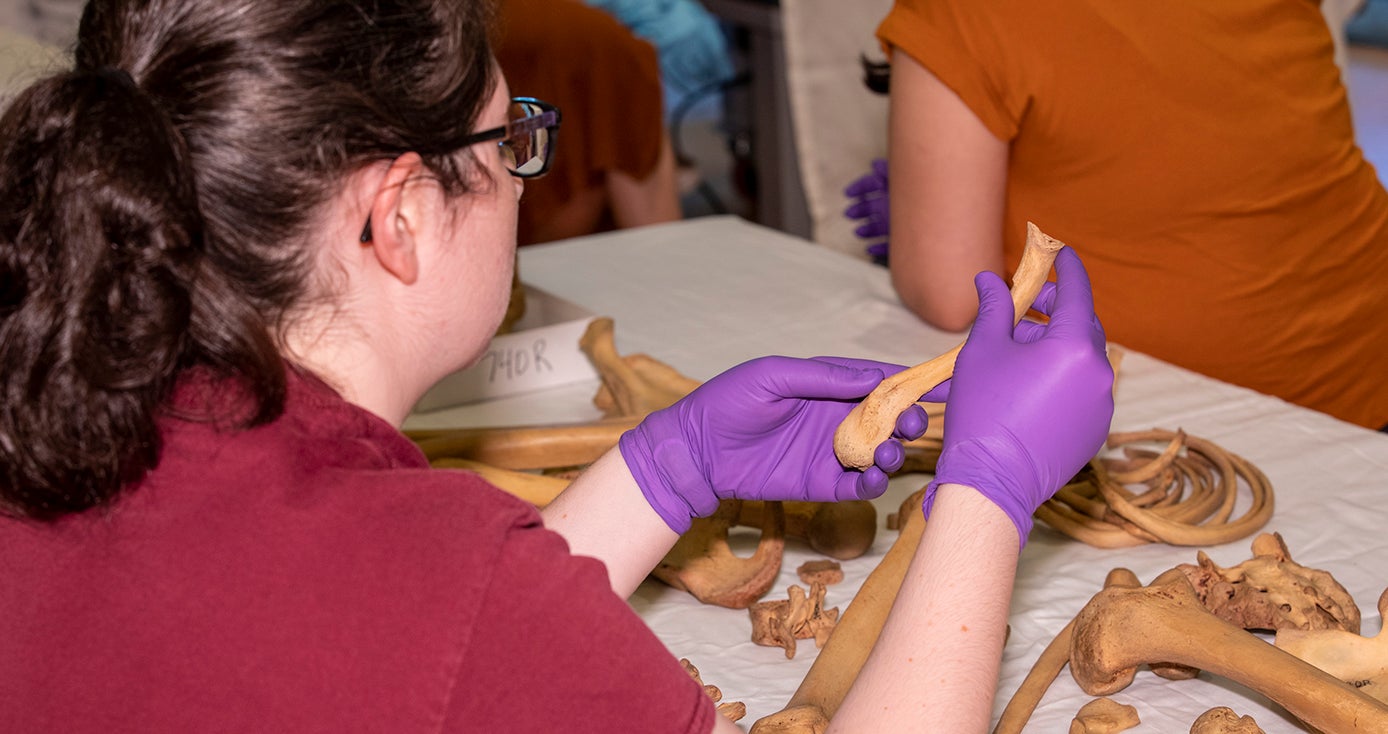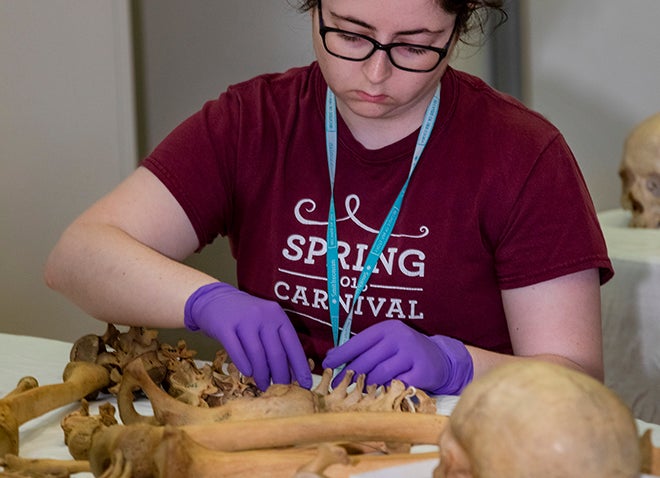
Subscribe to Pittwire Today
Get the most interesting and important stories from the University of Pittsburgh.Alumna Sheds Light on Understudied Part of African American History
When Bridget Hunt-Tobey took a course on human anatomy as part of Pitt’s Biomedical Master’s Program in fall 2018, her goal was to gain a more solid understanding of the body in preparation for medical school.
Along the way, a unique internship with the Smithsonian showed her how critical understanding anatomy is in explaining the lives of a population disregarded by American history.
Hunt-Tobey (MED ’19), now a research technologist studying chronic kidney disease at Northwestern University’s Feinberg School of Medicine, spent the summer of 2019 studying the remains of enslaved and free African Americans who worked at the Catoctin blast furnace in Maryland through the Smithsonian American Women's History Initiative's Because of HER STORY Internship. The first-ever internship was created to give students hands-on experiences with museum education and research so they can conduct public outreach efforts highlighting the initiative’s work.
The internship wasn’t exactly in line with Hunt-Tobey’s path toward the medical field, but it fueled the interests that steered her toward medicine in the first place.
“I majored in history and biology as an undergraduate and I’ve always really loved studying both, but hadn’t found too many opportunities to combine them. That project allowed me to use my expertise in anatomy and biology and physiology combined with talking about the historical impact of our findings,” said Hunt-Tobey.
She had no clue how critical those findings were to the stories of the enslaved in America until she started work with her mentor, Smithsonian Museum Specialist in Skeletal Biology Kari Bruwelheide, and uncovered how much historical data is missing from that narrative.
She learned in the United States there hasn’t been an extensive amount of anthropological study of the colonial times and post-revolutionary war, and that most of the field focuses on more ancient individuals or forensic cases.
“What we were working on, because it was in a slave cemetery and because it’s African American history, there isn’t a lot of documentation. We don’t know the names of any of the enslaved. We know they were there because we have the remains but there’s not much information from that population at all. The work we were doing can add to that,” Hunt-Tobey said.
She added: “You don’t typically understand history through analysis of bones, you understand it from documents and artwork and storytelling, and this is one more way to do it. But for a population like enslaved African Americans, where there’s very little documentation in the first place, it’s one of the only options now.”
This is particularly true for the formerly enslaved and free Black Americans who ran the Catoctin Furnace during its early years, said Bruwelheide.
Uncovering untold stories
The charcoal blast furnace Hunt-Tobey studied, which operated from around 1776 until 1903, forged iron used for items ranging from household tools to stoves to the cannonballs fired by George Washington’s troops during the battle at Yorktown. The furnace’s original operators, including Maryland’s first governor, Thomas Johnson, were known slave owners who did not maintain records on the lives of laborers.
By the mid 1800s, European immigrants began filling roles at the furnace, and the presence of the enslaved and free African Americans on the site slowly diminished.
“The absence of the story of the enslaved and free Black labor force at the furnace is one of tragedy of slavery writ large: namely, the lace of a descendant community and erasure of the Black population and collective heritage from an era,” said Bruwelheide.
The process of rediscovering those stories began in earnest in 2015—four decades after the Maryland State Highway Administration uncovered remains of African Americans from the late 18th and early 19th century during a road expansion project. By that time, techniques such as forensic facial reconstruction—which uses a combination of skeletal remains, anthropology, artistry and other techniques to determine an individual’s appearance before death—were available to assist researchers who were also working with much more biological data than what was available for their predecessors.
“The results of [this] investigation add to a growing body of biological data on the varied experiences of early African Americans, and demonstrate the benefit of using multiple lines of evidence and comparative approaches for studies of individual and group identity and health, particularly for people with limited recorded history. Of particular interest is the use of DNA to establish ancestral origins, familial relationships and possible genetic markers of disease,” Bruwelheide said.
For Hunt-Tobey’s role, she leaned on the new and the old. She used genetic marker information, data gleaned from the skeletons’ structures, potential environmental contaminants at the furnace and information from medical literature and studies to paint a broader picture of what their everyday lives might have looked like.
Some cases, such as a group of skeletons with elongated skulls caused by craniostenosis—a condition where an infant’s skull bone fuses over its brain too early and interferes with future growth—will help researchers study potential genetic implications of the condition. Others, such as telltale calluses on femurs, indicated the person likely worked as a cobbler and used their leg as a platform for hammering out soles.
One case in particular stood out to Hunt-Tobey because it told the unique story of a single woman. The woman’s femur was misshapen due to what paleopathologists later determined to be a result of Legg-Calve-Perthes disease, a condition that disrupts blood flow to the hip joint during childhood and gradually causes the bone to die.
Typically, the blood flow returns and the afflicted are stuck with brittle hip and femur bones that eventually heal. Unfortunately, at the furnace, recovery time wasn’t an option for the woman.
“Instead of forming the classic ball shape you see in a femur, it looked like a mushroom head,” said Hunt-Tobey. “She was able to walk and lived to be 35 or 40 years old, but she most likely walked with a limp and had some pain in her hip.”
Hunt-Tobey credited an anatomy course she took with professor Sandra Murray in the Department of Cell Biology for providing the foundation necessary to complete the internship. The course also gave her an eye for detecting abnormalities in bone and a few soft skills that can help her advance in her new position as a kidney researcher.
“The reason anthropologists can learn as much as they do about an individual and extrapolate that to a population is by really focusing on minute details. That has already been something I’ve needed at this new job,” Hunt-Tobey said.



